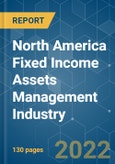North American Asset Management Industry is the largest with around 57% of global AuM from this region. While average assets under management (AUM) in North America edged up nearly 7 percent for 2018 to $43 trillion, the industry’s aggregate revenue pool gained just 1 percent and, facing a rising cost bill, industry profits fell nearly 4 percent. Net flows for the year were anemic, and the drop in both equity and bond markets late in the year made for a weak fourth quarter and a challenging start to 2019.
It is built around two core asset classes - equities followed by fixed-income assets, both combined, contributing to more than half the portfolios. The past couple of decades have seen a significant shift in fixed income assets from active to passive investment strategies. We examine the potential effects of this shift on financial stability through different channels such as liquidity transformation and redemption risks; strategies that amplify market volatility; increases in asset-management industry concentration; and the effects on valuations, volatility, and comovement of assets that are included in indexes.
Fintech and Regtech prominence is re-shaping the way asset management firms conduct business.
Key Market Trends
Prominence of HNWIs in Fixed Income Investments in North America
High Net Worth Individuals in North America are the second largest population with around 20 trillion USD wealth. They are so crucial for the asset management firms that they leave no stone unturned when it comes to improving the HNWI client relationship. Asset management firms managing the HNIs wealth have clearly given prominence to fixed income given their long-term investment horizon. An infographic explaining the asset allocation of HNWIs in North America in 2019 is presented below.
Active Vs Passive: Wealth Managers Take on Fixed Income Assets
Asset Managers have been observing a clear trend of active to passively managed shift in fixed income and other asset classes. Even if the migration from active to passive continues at the same pace as the past several years, active fixed income strategies will still make up a large proportion of the aggregate AUM and revenue base of North American managers. The shift from active to passive investment strategies appears to be increasing some types of risk while diminishing others: The shift has probably reduced liquidity transformation risks, although some passive strategies amplify market volatility, and passive-fund growth is increasing the asset-management industry concentration.
Competitive Landscape
The report includes an overview of asset managers operating across North America or in one or a few countries within the region. We wish to present detailed profiling of a few major companies which cover their product offerings, regulations governing them, their headquarters, and financial performance. Currently, some of the major players dominating the market are listed below.
Additional Benefits:
- The market estimate (ME) sheet in Excel format
- 3 months of analyst support
This product will be delivered within 2 business days.
Table of Contents
Methodology

LOADING...








